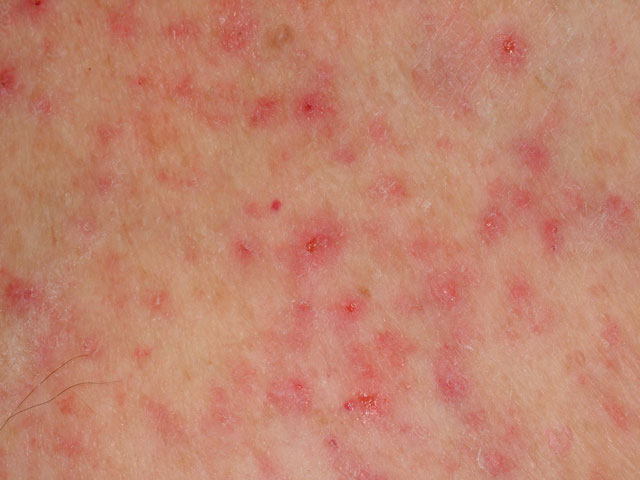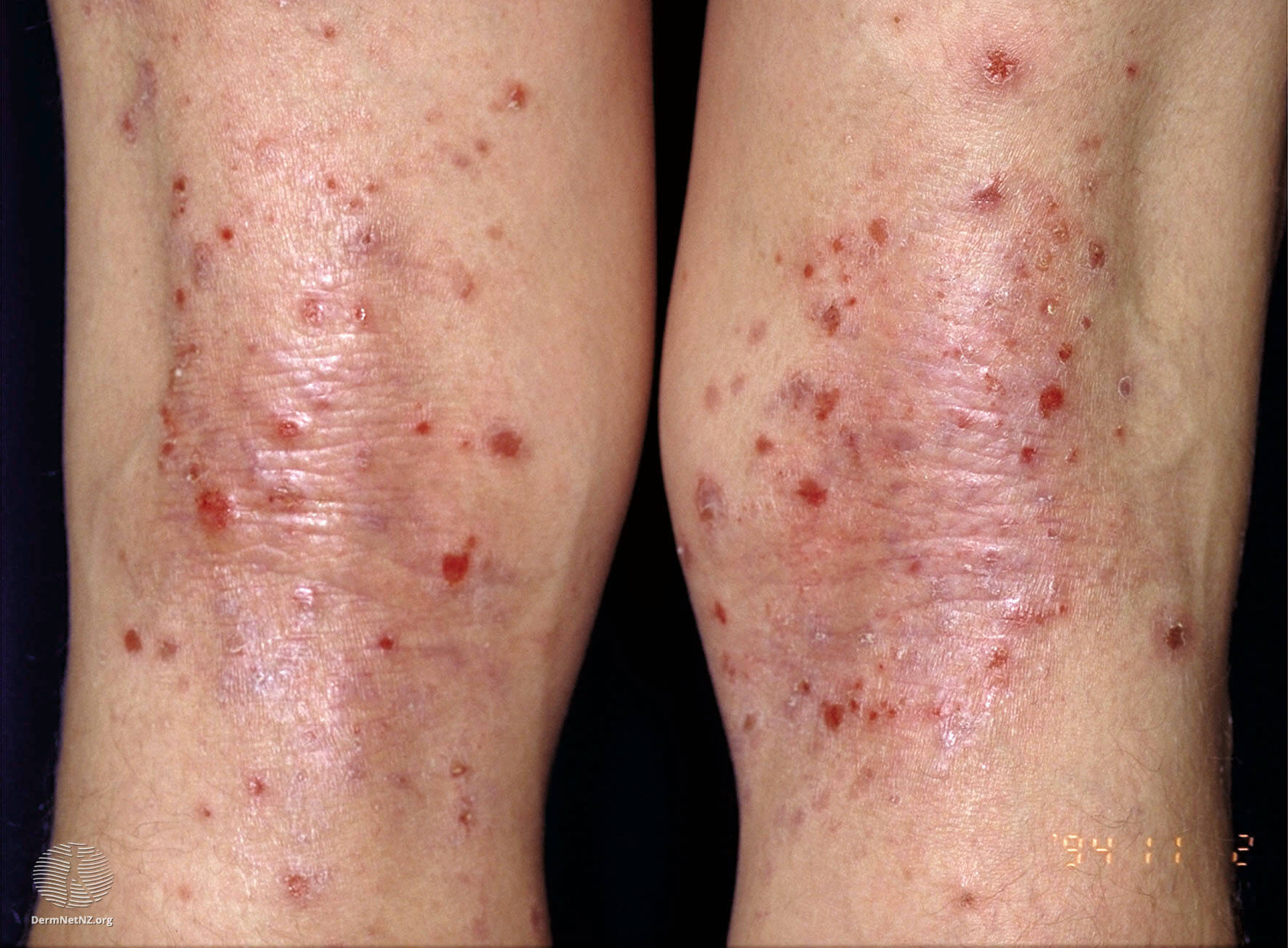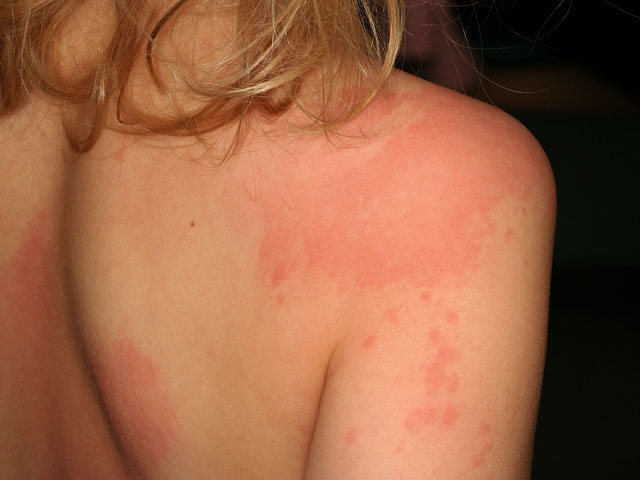Browse the collection of hives photos below.
The text throughout the Atlas can be referenced from DermNet NZ (see below). Commentary has also been provided by Dr Katherine Armour.
DermNet New Zealand. Topics A-Z. Palmerston North, Manuwatu (New Zealand) DermNet New Zealand Trust 2021. Available from https://dermnetnz.org/ Accessed August 2021.

Urticaria pigmentosa
Image used with permission from DermNet New Zealand
Urticaria pigmentosa (UP) is also known as maculopapular cutaneous mastocytosis. In this condition, brown patches or freckles develop on the skin due to abnormal collections of mast cells. These patches may blister or form a surrounding hive when rubbed. This is usually very itchy
Urticaria pigmentosa most commonly develops in infants, but may also occur for the first time in adults.

Hives (urticaria) on a leg
Image used with permission from DermNet New Zealand
Urticaria is a rash in which you see wheals (hives) or angioedema (deeper swellings) or both. A wheal is a superficial pink or pale skin swelling, usually surrounded by a rim of redness. The surface of the skin is smooth in urticaria. Wheals may last anything from a few minutes to 24-48 hours. Urticaria is usually very itchy, but may be burning in nature in some individuals. Angioedema may be quite painful (especially if it affects the hands and feet). There is no colour change to the skin in angioedema.

Hives (urticaria) on the body
Image used with permission from DermNet New Zealand
In this picture we see the characteristic rash of urticaria, with a pale, smooth central skin swelling, and a well-defined red border. The lesions (or spots) of urticaria may vary from 2-4mm to a huge single swollen area which may involve a whole limb. Urticaria may affect the skin anywhere on the body and the mucous membranes (inside the mouth, and genitals in women).

Psoriasis plaques on the body
Image used with permission from DermNet New Zealand
In the most common form of psoriasis (chronic plaque psoriasis), well-defined red scaly areas of skin are seen, called “plaques.” The most common sites to see chronic plaque psoriasis are the scalp, elbows and knees, nails, hands, feet, and trunk (including the intergluteal fold which is the area between the buttocks). Contrary to popular belief, psoriasis is often very itchy.

Sweat rash (miliaria) on the body
Image used with permission from DermNet New Zealand
Miliaria is relatively common. It is caused by blockage and/or inflammation of the ducts that lead from the eccrine sweats glands to the surface of the skin. Miliaria is commonly seen in hot and humid climates, patients in hospitals and in newborn babies. In contrast to the short-lived rash of urticaria (in which individual spots always resolve within 24 or a maximum of 48 hours), miliaria will last for days-weeks.
There are 4 types of miliaria:
Miliaria crystallina – in which we see tiny clear blisters that easily break. The blisters can look like beads of sweat. The blisters are usually seen widely dispersed on the head, neck, and upper trunk. This rash is most commonly seen in newborn babies, but may also occur in adults with a fever.
Miliaria rubra is the most common type of miliaria, and is what we see in this picture. The spots are 2-4mm red bumps, some of which may develop a tiny area of blistering (called vesicles). This condition is very itchy.
Miliaria pustulosa is a subtype of milia rubra in which pustules are seen.
Miliaria profunda is when deep bumps 1-3 mm in size occur. This rash tends not to be itchy and occurs after repeated episodes of miliaria rubra.

Guttate psoriasis covering the back and shoulders
Image used with permission from DermNet New Zealand
In guttate psoriasis, small, scaly, red spots (papules) and plaques are seen. Each spot will last days-weeks. Guttate psoriasis is more commonly seen in children and young people and is commonly preceded by an upper respiratory tract infection. Guttate psoriasis may be itchy or asymptomatic.

Erythema multiforme on an arm
Image used with permission from DermNet New Zealand
The typical spots seen in erythema multiforme are seen in this photo. These are the target (or “iris”) lesion. There is a sharp border, a round shape and three concentric colour zones:
a) The centre: this is dark red or dusky, and eventually develops a blister or crust
b) The middle ring – is a paler pink and is raised due to fluid swelling in the skin
c) The outermost ring – bright red
The lesions of erythema multiforme usually develop over 72 hours, with blistering or crusting seen by this time in the central area of the spots. In erythema multiforme there may be mild itch or burning as well as the crusting on the skin. This is in contrast to the intense itch and smooth spots or plaques seen in urticaria.

Cold-induced urticaria on an arm
Image used with permission from DermNet New Zealand
The wheals seen in cold urticaria look no different from spontaneous urticaria. They can be differentiated by the history of how they occur.
Symptoms of cold urticaria become obvious within 2–5 minutes after cold exposure and last for 1–2 hours. They include:
• Itchy wheals and angioedema that may be localised (affecting certain parts of the body) or generalised (rash over the whole body). The wheals seen in cold urticaria may be small or large, and may join up to involve large areas.
• In some cases systemic symptoms may develop (anaphylaxis)
o Shortness of breath, wheezing
o Abdominal pain, gastrointestinal ulcers
o Rapid and irregular heartbeat (palpitations)
• In very severe cases hypotension (drop in blood pressure), shock, collapse and even death may occur.
Swimming in cold water is the most common cause of a severe cold urticarial reaction. Patients who have been diagnosed with cold urticaria should never swim alone.

Heat-induced (cholinergic) urticaria on the arms
Image used with permission from DermNet New Zealand
In cholinergic urticaria, multiple, transient, 2-4mm diameter wheals are seen. They are surrounded by a bright red flare.
Cholinergic urticaria occurs within 15 minutes of a sweat-inducing stimulus. These stimuli include:
-Physical exertion
-Hot baths/showers
-Emotional stress
-Moving from a cold to a hot room
-Drinking alcohol and eating spicy food
In cholinergic urticaria, the rash appears rapidly, usually within a few minutes of sweating. It can last from 30-60+ minutes, before fading away. The rash is often itchy, and may appear anywhere on the body. However, it is most prominent on the upper trunk and arms.

Chickenpox blisters on the face
Image used with permission from DermNet New Zealand
Chickenpox usually begins as itchy red bumps called papules. These develop into vesicles (small blisters) on the trunk and face, before spreading to other parts of the body. Vesicles can also arise inside the mouth. The vesicles of chickenpox tend to be very itchy. Systemic symptoms may be seen in chickenpox (in children and especially in adults) including high fever, headaches, cold-like symptoms, vomiting and diarrhoea
The vesicles of chickenpox clear up within one to three weeks. Some of the vesicles may heal with scars.

Atopic dermatitis (eczema) on the legs
Image used with permission from DermNet New Zealand
Like urticaria, atopic dermatitis is an intensely itchy skin condition. In atopic dermatitis, red scaly patches are seen. These tend to have a less-defined border than we see in psoriasis. Atopic dermatitis tends to look quite different during different times of life, and evolves over time in terms of the areas of the body affected.
In this person, there has been lots of scratching and the eczema looks very raw and inflamed in some areas. Crusting from weeping (exudation) of the skin can be seen in other areas. This differs to urticaria, which is very itchy, but the surface of the skin is rarely broken by scratching. The skin in urticaria tends to remain smooth.

Atopic dermatitis (eczema) on the back of an adult
Image used with permission from DermNet New Zealand
In this patient we can see thickening of the skin (lichenification) from long periods of rubbing and scratching. There is also a lot of brown coloration in the skin called “post-inflammatory hyperpigmentation.” This is a footprint of where the inflammation of previous eczema has been.

Annular erythema eruption on the body
Image used with permission from DermNet New Zealand
Annular erythemas are a group of different rashes that are red, and may be smooth or scaly. The smooth variants can look similar to urticaria, but differ in their duration (days-months).
Annular erythemas begin as a small raised pink/red spot that slowly enlarges and forms a ring shape, while the central areas flattens and clears. The rim may be smooth or scaly. The rings usually grow to about 6-8cm in diameter. Irregular shapes, and incomplete rings may be seen. Single or multiple rings may be seen. The thighs and legs are commonly affected sites. The face, trunk and arms are occasionally affected. This rash rarely causes discomfort. Mild itching or stinging is sometimes seen.

Cold-induced urticaria after removal of an ice cube
Image used with permission from DermNet New Zealand
In this image, a classical hive of urticaria has been induced by application of an ice cube to a patient with cold urticaria. Here we can see the typical smooth, pale central raised area of skin, with a surrounding red halo. We would expect this hive to resolve within 1-2 hours. The hives of chronic spontaneous urticaria may last up to 24 or even uncommonly, 48 hours.

Urticaria (hives) on the skin
Image used with permission from DermNet New Zealand
In this image we can see the classical smooth, pink skin swelling of urticaria. There are occasional small plaques. But, many of the smaller lesions have joined up to form large plaques that are extremely itchy. These areas of rash will take 24-48 hours to resolve. While this rash is evolving, new areas of urticaria are likely to develop. The severe itch and lack of predictability of which area of the body will be affected next can make urticaria a very distressing condition.

Angioedema (swelling) of eye area
Image used with permission from DermNet New Zealand
Angioedema is deeper swelling within the skin or mucous membranes, and can be skin-coloured or red. It tends to resolve within 72 hours. This swelling may be painful, itchy, or asymptomatic. The disfigurement caused by angioedema on the face (even if only temporary) can be very distressing to the patient. Approximately 40% of individuals with urticaria also experience angioedema at times.

Hives on the thigh of a person with urticaria
Image used with permission from DermNet New Zealand
Whilst the urticaria in this patient overall looks rather red in hue, you can still discern the paler central swollen areas of skin surrounded by a darker red rim at the edge. Here we can see a mixture of small wheals as well as are larger plaques where small wheals have merged together.

Large hives (wheals) on a person affected by urticaria
Image used with permission from DermNet New Zealand
This image shows just how large hives of urticaria can become. There are small wheals at the edge of some very large plaques of urticaria. All of the affected areas appear smooth rather than scaly (as you would see in atopic dermatitis or psoriasis).

Hives appearing as raised, red lumps on the skin
Image used with permission from DermNet New Zealand
In this photo, you get a sense that the urticaria is “migrating”. You can see a pink area centrally where old hives have resolved, and a very red, angry- looking, lumpy edge where new hives are forming and are merging together. This history in which you see hives at all stages of evolution is classical for urticaria. Dermatologists often ask patients when they are diagnosing urticaria, “If I drew a ring around this spot with my pen, would it still be there in 24 hours? Or, would this spot have resolved and a new hive have popped up nearby.”